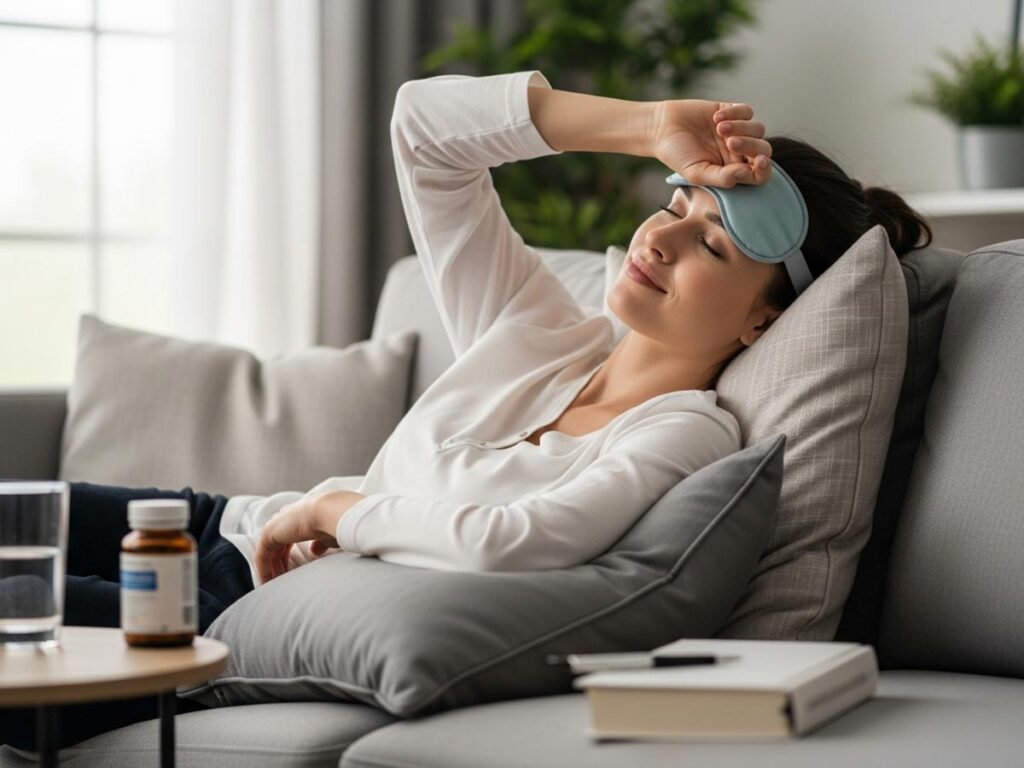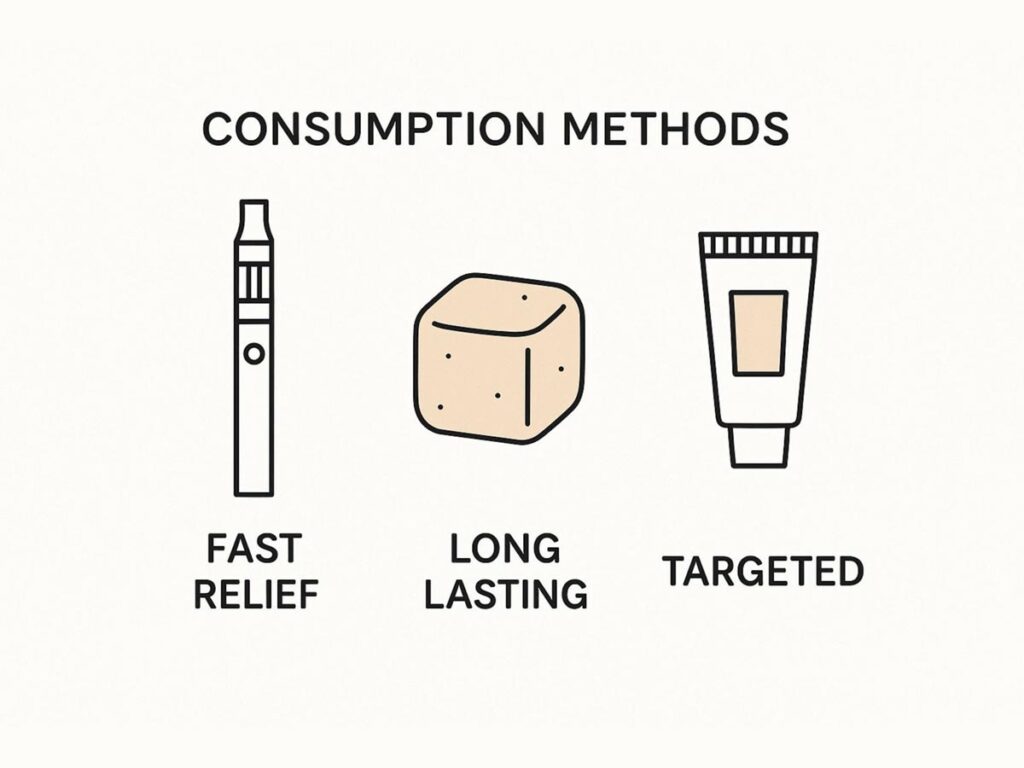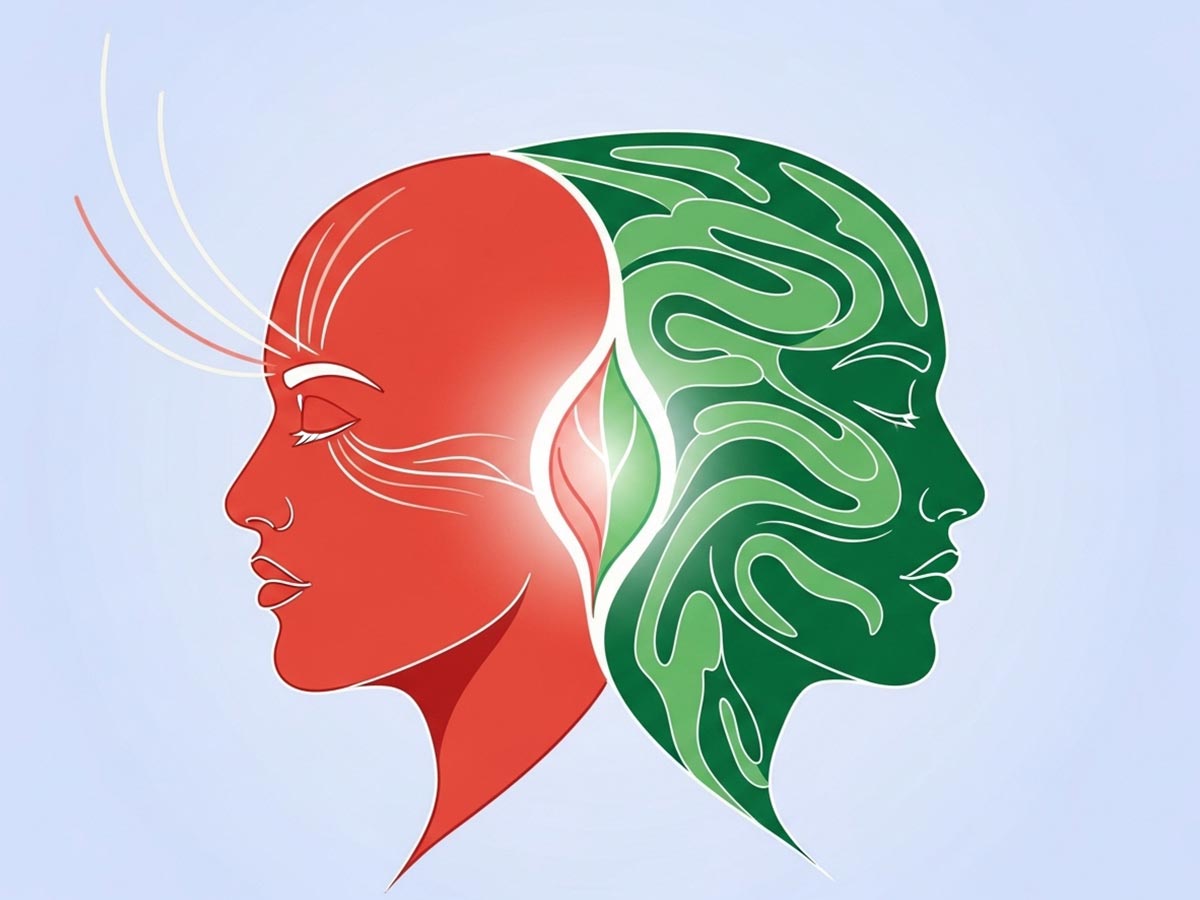If you’ve ever found yourself in a dark room, willing a migraine to just stop, you know how desperate the search for relief can be. When traditional medications fall short, many people are discovering that THC might be the key to finally quieting the storm in their heads. This isn’t about wishful thinking; it’s about science. THC works with your body’s own systems to reduce pain and inflammation, offering a new angle on managing migraine attacks.
Your Quick Guide to Using THC for Migraines
For millions, a migraine is more than just a headache—it’s a debilitating neurological event that can hijack your life for hours, sometimes days. While prescriptions help some, they’re not a perfect solution for everyone. That’s why a growing number of people are exploring cannabis, and specifically THC, as a powerful ally in their fight for relief.
The goal isn’t to replace your entire treatment plan. Instead, think of THC as a specialized tool you can add to your arsenal—one that might work when others don’t. Imagine a migraine as a chaotic mix of overactive pain signals, inflammation, and extreme sensitivity. THC steps in to calm that chaos, offering a multi-pronged approach to restoring balance and peace.
THC for Migraines: The Bottom Line Up Front
Getting started can feel overwhelming, so here’s a straightforward summary of what you need to know when considering THC for your migraine symptoms.
| Consideration | Key Points |
|---|---|
| Potential Benefits | Expect fast-acting pain relief, reduced nausea, and, for some, a noticeable drop in how often migraines strike. |
| Associated Risks | Dizziness or anxiety can occur, especially with a dose that’s too high. The key is starting with a tiny amount. |
| Common Methods | Inhaling (vaping) offers near-instant relief. Edibles provide a slow, steady effect that lasts for hours. |
| Key Compounds | THC is the primary pain-reliever, while its partner, CBD, brings powerful anti-inflammatory and calming benefits. |
This table gives you a high-level view, but the real story is in the science, which is finally validating what users have reported for years.
What the Research Says About THC for Migraines
The science is catching up to personal experience. A groundbreaking double-blind study provided compelling data: vaporized cannabis with both THC and CBD delivered significantly better pain relief within two hours compared to a placebo.
Even better, the relief stuck around. A large number of participants remained pain-free a full 24 to 48 hours later. The study also confirmed what many already knew: inhalation was the preferred method for fast relief, used by over 81% of participants to stop an attack in its tracks. You can explore these important cannabis and migraine findings directly on the National Institutes of Health website.
How THC Interacts with Migraine Pain Pathways
To understand why THC works, you first need to know about a system you were born with: the endocannabinoid system (ECS). Think of it as your body’s master regulator, constantly working to maintain balance across everything from pain and mood to sleep and appetite.
When a migraine hits, your ECS is thrown into disarray. Pain signals fire uncontrollably and inflammation flares, creating that familiar, throbbing agony.

This is where THC becomes your ally. As a cannabinoid, THC’s molecular structure is remarkably similar to the natural compounds your body uses to run the ECS. When you introduce THC, it binds to cannabinoid receptors, giving it a direct line to influence how your body perceives and responds to pain.
Targeting Pain at the Source
THC primarily interacts with two types of cannabinoid receptors: CB1 and CB2. These receptors are located throughout your body, but they’re highly concentrated in the exact areas a migraine attacks—your brain, central nervous system, and immune cells.
- CB1 Receptors (in the brain): When THC activates these, it effectively tells overactive nerves to calm down. It’s like turning down the volume on your pain signals, reducing their intensity at the source.
- CB2 Receptors (in the immune system): By activating these receptors, THC helps suppress inflammation—a key driver of the intense, physical pain of a migraine.
THC delivers a powerful one-two punch: it directly interrupts pain signals while simultaneously fighting the inflammation that fuels the fire.
This dual-action mechanism is why the connection between THC and migraine relief is so compelling. It’s not just masking the pain; it’s interacting with the root causes of the attack.
The Endocannabinoid Deficiency Theory
Why does our internal system sometimes fail, leaving us vulnerable to migraines? One leading theory is Clinical Endocannabinoid Deficiency (CECD).
The idea is straightforward: some people may naturally produce fewer endocannabinoids, leaving their pain and inflammation systems poorly regulated. This shortfall could make them significantly more susceptible to migraine triggers.
Preclinical studies are exploring this, suggesting this imbalance may be a critical piece of the migraine puzzle. This research is paving the way for cannabinoids to be used to correct this deficiency and stop the migraine chain reaction before it begins. To learn more, you can explore the ongoing research on the connection between cannabinoids and migraines.
Ultimately, THC isn’t just a band-aid. It engages with the very systems your body uses to manage pain, offering a chance to restore balance when your own defenses are overwhelmed.
Choosing The Right THC Method For Your Migraine
When a migraine is bearing down on you, how you take THC is just as important as the dose. The right delivery method can be the difference between stopping the pain in its tracks or anxiously waiting for relief that arrives too late. The key is to match the method to your need: are you trying to shut down an active attack, or are you seeking long-term, preventative support?
Think of it this way: for a sudden, sharp pain, you’d grab a fast-acting painkiller. For chronic inflammation, you might take a daily, slow-release medication. THC products work the same way. Different methods deliver THC into your system at different speeds and for different durations, so choosing the right tool for the job is essential.
Let’s break down the most common options to help you decide what’s best for your migraine needs.

As you can see, there’s no single “best” method. The ideal choice depends entirely on your symptoms and your goals.
To make it even clearer, here’s a practical comparison of the most common options.
Comparing THC Consumption Methods for Migraine Relief
This table breaks down the crucial differences between inhalation, oral methods, and topicals. Focus on the onset and duration times—these are the most important factors for deciding between fast-acting and long-term relief.
| Method | Onset Time | Duration | Best For |
|---|---|---|---|
| Inhalation (Vaping, Smoking) | 5-10 minutes | 1-3 hours | Acute Relief: Stopping a migraine the moment it starts. Its rapid onset is perfect for “abortive” care. |
| Oral (Edibles, Tinctures) | 30 minutes – 2 hours | 6-8+ hours | Preventative Care: Providing steady, long-lasting support to help reduce the frequency and intensity of migraines. |
| Topicals (Creams, Balms) | 15-30 minutes | 2-4 hours | Targeted Relief: Soothing localized pain in your neck, shoulders, or temples without any psychoactive effects. |
The goal is to match the product’s profile to your immediate needs. An edible won’t help you in the middle of a sudden attack, while vaping may not provide the sustained background relief you’re looking for.
Inhalation for Fast-Acting Relief
You know the feeling: the first shimmer of a visual aura, a tell-tale stiffness in your neck, or that dreaded sensitivity to light. When those warning signs appear, speed is your greatest asset. This is where inhalation methods, like a vaporizer, truly shine.
When you inhale THC, it absorbs directly into your bloodstream through your lungs, bypassing the digestive system entirely. This provides incredibly fast relief, often within 5 to 10 minutes. This rapid action makes it the perfect choice for an abortive treatment—something that can stop a migraine from reaching its agonizing peak.
- Best For: Immediately addressing a migraine attack the moment you feel it coming on. For example, taking a single puff from a vape pen as soon as the aura appears.
- Duration: The effects kick in fast but are shorter-lived, typically lasting 1-3 hours.
- Consideration: Because you feel the effects almost instantly, it’s much easier to gauge your dose and avoid overconsumption.
Oral Methods for Long-Lasting Support
If your goal is prevention—reducing how often migraines strike or managing the lingering exhaustion after an attack—oral methods are your go-to. This includes edibles, capsules, and tinctures placed under the tongue.
When you ingest THC, your liver converts it into a more potent and longer-lasting compound. The trade-off? It takes time. You could wait anywhere from 30 minutes to two hours to feel the effects, which makes edibles a poor choice for a sudden attack.
But once they take effect, the relief can last for 6-8 hours or even longer. This slow, steady release is ideal for maintaining a consistent level of support, potentially reducing the overall frequency and intensity of your migraines. For instance, taking a low-dose edible in the morning could help manage symptoms throughout the workday.
For a deep dive into what to expect, read our guide on how long edibles last, which breaks down the entire process from ingestion to effect.
Topicals for Targeted, Non-Intoxicating Aid
A migraine is rarely just a headache. It often brings along excruciating neck pain, tense shoulders, and stiff muscles around your temples. For this type of localized pain, THC-infused topicals like creams, balms, and lotions are a game-changer.
Topicals work by interacting with cannabinoid receptors in your skin and muscles without entering your bloodstream in significant amounts. This means you get powerful, targeted pain and anti-inflammatory relief exactly where you need it, with zero psychoactive high.
- Best For: Soothing migraine-related muscle tension. For example, massaging a THC balm into your neck and shoulders while you rest in a dark room.
- Onset: You’ll typically feel relief within 15-30 minutes.
- Benefit: It provides localized comfort without altering your mental state, so you can use it anytime, anywhere.
Finding Your Minimum Effective Dose

When using THC for migraines, the most important rule is to start low and go slow. Unlike a standard painkiller, THC’s effects are highly personal. Your ideal dose depends on your metabolism, body weight, tolerance, and even what you’ve eaten that day.
Your goal is not to get high; it’s to find your minimum effective dose (MED). This is the sweet spot—the smallest amount of THC that provides noticeable symptom relief without causing unwanted side effects like anxiety or brain fog. Finding your MED requires patience, but it’s the key to a successful experience.
Starting Your Dosing Journey
If you’re new to THC, microdosing is the smartest approach. A microdose is a tiny, sub-perceptual amount—too low to cause intoxication, but just enough to activate your body’s endocannabinoid system and provide relief.
Here’s a practical guide to starting:
- For Edibles: Start with a very small dose, such as 2 mg of THC. Since many gummies come in 5 mg or 10 mg pieces, you’ll need to cut one carefully into smaller portions. Be patient and wait at least two full hours to assess the effects before even considering taking more.
- For Inhalation: If you’re using a vaporizer, take a single, short puff. The effects are much faster, so you can check in with yourself after 15-20 minutes. From there, you can decide if another small puff is needed.
The “start low, go slow” method puts you in complete control. It empowers you to find relief on your terms, minimizing risks and helping you build a predictable, reliable relationship with THC as a migraine management tool.
This methodical approach ensures you stay comfortable and in charge as you learn what works best for your body. It’s a journey of discovery, not a race.
Tracking Your Progress to Find Your Balance
To truly master your dosage, keeping a simple journal is invaluable. You can use a notes app on your phone or a small notebook. Tracking your experiences helps you identify patterns and adjust your approach with confidence.
Here’s what to log for each use:
- Date and Time: Note when the migraine started and when you took your dose.
- Product and Dose: Be specific. Write down “2 mg THC gummy” or “one 2-second pull from the vape.” Understanding the compounds is also helpful; for instance, learn what sets THCA vs. THC apart.
- Symptom Changes: Rate your pain on a scale of 1-10 before dosing. Check in again an hour later. Do the same for other symptoms like nausea or light sensitivity.
- Side Effects: Did you feel anything else? Drowsy? A little anxious? Make a quick note.
After just a few entries, a clear picture will emerge. You might discover that 2 mg isn’t quite enough, but 3 mg is the perfect dose that provides relief with no side effects. This simple habit removes the guesswork, empowering you to use THC for your migraines safely and effectively.
The Risks and Legal Maze You Need to Navigate
Before deciding if THC is right for you, it’s crucial to understand the full picture—not just the benefits, but also the potential risks and the complex legal landscape.
Let’s be clear: THC isn’t for everyone. Some people experience side effects like dizziness, dry mouth, or a spike in anxiety, particularly with doses that are too high. One of the best strategies to minimize these effects is to choose products that also contain cannabidiol (CBD). Think of CBD as THC’s balancing partner; it’s non-intoxicating and can help counteract the “high,” leading to a smoother, more comfortable experience. Learn more about how CBD can help with headaches and migraines.
A Word of Caution on Side Effects
A significant risk to be aware of is Medication Overuse Headache (MOH). This is a rebound effect that can occur with the frequent use of any acute pain reliever, including THC. As a general guideline, avoid using THC for acute migraine relief more than 10 days per month. If you find yourself reaching for it daily, it’s a signal to speak with your doctor to ensure you aren’t creating a cycle of rebound headaches.
This isn’t a new concern. Historical medical texts show that doctors prescribing cannabis for headaches before prohibition warned of this very issue, stressing that consistent, moderate dosing was key to success. You can read more about the historical use patterns of cannabis for headaches.
Untangling the Legal Mess
The legality of using THC for migraines is a confusing patchwork of state and federal laws. What is legal and accessible in one state could lead to serious legal trouble just across the border.
This map illustrates the varying legal status of medical cannabis across the United States.
Before purchasing or using any THC product, you must verify the laws in your specific location. A quick search for your state’s current cannabis regulations on a government website is an essential first step to ensure you stay safe and compliant with the law.
Your Questions About THC and Migraines, Answered
Diving into the world of THC for migraine relief naturally brings up questions. Here are clear, straightforward answers to some of the most common ones.
Is THC a Migraine Cure?
No, THC is not a cure for migraines. It is best understood as a powerful tool for symptom management. For many, it’s highly effective at aborting a migraine attack or reducing the frequency of episodes. However, it works best as part of a comprehensive wellness plan, not as a standalone solution.
Do I Have to Get High to Get Relief?
Absolutely not. The goal is therapeutic, not recreational. By finding your minimum effective dose (MED), you can achieve significant symptom relief without an intoxicating high. Microdosing, choosing products with a high CBD-to-THC ratio, or using non-psychoactive topicals are all excellent strategies for separating the pain-relieving benefits from the “high.”
The primary objective is therapeutic relief, not intoxication. Careful dosing and product selection are key to separating the pain-relieving benefits from the psychoactive effects of THC.
What’s the Difference Between THC and CBD for Migraines?
Think of them as a team with different specialties. THC is the heavy hitter, known for its potent, fast-acting pain-relieving properties that can be a lifesaver during an acute attack. CBD is non-intoxicating and excels at reducing inflammation and anxiety. It works on the underlying triggers and helps calm the nervous system. Often, a product containing both is more effective than either one alone.
How Do I Even Bring This Up With My Doctor?
Be direct and honest. A great way to start the conversation is by saying something like, “My current treatment isn’t providing enough relief, and I’ve been researching medical cannabis as a potential option. I’d like to discuss if it could be a safe addition to my plan.”
The most important points to cover are potential interactions with your current medications and getting their professional guidance on dosing. Your doctor needs the full picture to provide the best and safest care. For general background information, reliable resources like Wikipedia’s page on medical cannabis can be a helpful starting point for your research.
At Wallflower Cannabis House, our knowledgeable team is passionate about helping people navigate their options for wellness. We’re here to answer your questions and help you find a product that fits your unique needs. Visit us online to explore our curated selection.

